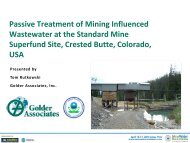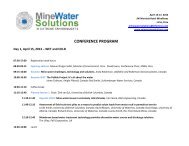Frozen Dams in Permafrost Regions - Mine Water Solutions
Frozen Dams in Permafrost Regions - Mine Water Solutions
Frozen Dams in Permafrost Regions - Mine Water Solutions
You also want an ePaper? Increase the reach of your titles
YUMPU automatically turns print PDFs into web optimized ePapers that Google loves.
<strong>Frozen</strong> <strong>Dams</strong> <strong>in</strong><strong>Permafrost</strong> <strong>Regions</strong>Megan Miller, SRK Consult<strong>in</strong>g (Canada) Inc., CanadaJohn B. Kurylo, SRK Consult<strong>in</strong>g (Canada) Inc., CanadaMaritz Rykaart, SRK Consult<strong>in</strong>g (Canada) Inc., Canada
AcknowledgementsThe authors would like to thank the follow<strong>in</strong>g for mak<strong>in</strong>g this paper possibleHope Bay M<strong>in</strong><strong>in</strong>g LimitedEBA Eng<strong>in</strong>eer<strong>in</strong>g Consultants Ltd,. A Tetra Tech CompanyOur colleagues at SRK Consult<strong>in</strong>g
Def<strong>in</strong>ition<strong>Frozen</strong> Core Dam: A dam <strong>in</strong> which the water reta<strong>in</strong><strong>in</strong>g structure is animpermeable frozen mass consist<strong>in</strong>g of the dam core and foundations.Thermosyphon: A passive refrigeration system, consist<strong>in</strong>g of a sealed tubefilled with pressurized gas and a radiator, that takes heat out of theground and disperses it <strong>in</strong>to the cold air.Source: Hockley 2013Simplified Schematic ofThermosyphon
Why Build a <strong>Frozen</strong> Core Dam?•Low permeability core material not available, or not suitable•The core of frozen core dams can be constructed of esker orcrushed rock and water•Foundations thaw susceptible•Foundation thaw<strong>in</strong>g would cause excessive settlement of thaweddam•Construction tim<strong>in</strong>g/sequence•Thawed dams cannot be constructed <strong>in</strong> w<strong>in</strong>ter
<strong>Frozen</strong> <strong>Dams</strong> Throughout HistoryPrimarily active freez<strong>in</strong>gPassive freez<strong>in</strong>g, us<strong>in</strong>g theextreme cold of theenvironmentLEGENDSummer Construction, Active Freez<strong>in</strong>g Summer Construction, Passive Freez<strong>in</strong>g W<strong>in</strong>ter Construction, Passive Freez<strong>in</strong>g
Trends: 1790s to early 1940sPurpose: <strong>Water</strong> storage dams for water supplyConstruction: W<strong>in</strong>ter or Summer with passive freez<strong>in</strong>gFreez<strong>in</strong>g apparatus: Noth<strong>in</strong>g or wooden shields<strong>Dams</strong> Include:PetrovskUpper KumakhshkayaUnnamed (Portovyy Creek)LEGENDSummer Construction, Active Freez<strong>in</strong>g Summer Construction, Passive Freez<strong>in</strong>g W<strong>in</strong>ter Construction, Passive Freez<strong>in</strong>g
Case Study: Petrovsk Dam, Russia• Constructed: 1792• Dimensions: Conta<strong>in</strong>ed head of 6 m• Construction Technique: W<strong>in</strong>ter Construction. Soilplaced <strong>in</strong> wooded cribwork, flooded and left tofreeze• Freez<strong>in</strong>g Apparatus: None• Foundation Conditions: Unknown• Performance: Satisfactory until 1929 (137 years)LEGENDSummer Construction, Active Freez<strong>in</strong>g Summer Construction, Passive Freez<strong>in</strong>g W<strong>in</strong>ter Construction, Passive Freez<strong>in</strong>g
Trends: 1940s to 1960sPurpose: <strong>Water</strong> storage dams for water supply or power stationsConstruction: Summer with active freez<strong>in</strong>gFreez<strong>in</strong>g apparatus: Vertical pipes with forced air/br<strong>in</strong>e/gas circulation<strong>Dams</strong> Include:Hess CreekDolgoyle LakeMiaunjo RiverUnnamed (Oyuur-Yurg River)Irelyakh RiverNoril’skLEGENDSummer Construction, Active Freez<strong>in</strong>g Summer Construction, Passive Freez<strong>in</strong>g W<strong>in</strong>ter Construction, Passive Freez<strong>in</strong>g
Case Study: Irelyakh River Dam, RussiaConstructed: 1961-1964Dimensions: 20 m high, 320 m longConstruction Technique: Summer construction.Source: Salyes 1987Freez<strong>in</strong>g Apparatus: Forced air circulation, verticalfreez<strong>in</strong>g columnsFoundations Conditions: Sandy gravel and silty clayswith up to 60% ice content.LEGENDSummer Construction, Active Freez<strong>in</strong>g Summer Construction, Passive Freez<strong>in</strong>g W<strong>in</strong>ter Construction, Passive Freez<strong>in</strong>g
Trends: 1970s and 1980sPurpose: <strong>Water</strong> storage dams for power station,tail<strong>in</strong>gs damsConstruction: Summer with passive freez<strong>in</strong>gFreez<strong>in</strong>g apparatus: Vertical pipes operat<strong>in</strong>g passively(precursor to modern thermosyphons)<strong>Dams</strong> Include:Anadyr’Dam 1A & 2 (Lup<strong>in</strong>)LEGENDSummer Construction, Active Freez<strong>in</strong>g Summer Construction, Passive Freez<strong>in</strong>g W<strong>in</strong>ter Construction, Passive Freez<strong>in</strong>g
Case Study: Anadyr’, RussiaConstructed: 1976Dimensions: 17 m high, 1,300 m longConstruction Technique: Near saturated material placed <strong>in</strong> summer and leftto freeze dur<strong>in</strong>g the follow<strong>in</strong>g w<strong>in</strong>ter; built <strong>in</strong> two liftsFreez<strong>in</strong>g Apparatus: Passive cool<strong>in</strong>g pipesFoundations Conditions: Sandy gravelly soil with30-80% ice, over frozen clay loamLEGENDSummer Construction, Active Freez<strong>in</strong>g Summer Construction, Passive Freez<strong>in</strong>g W<strong>in</strong>ter Construction, Passive Freez<strong>in</strong>g
1990s and 2000sPurpose: <strong>Water</strong> reta<strong>in</strong><strong>in</strong>g dams for tail<strong>in</strong>gs facilitiesConstruction Trend: W<strong>in</strong>ter with passive freez<strong>in</strong>g, material placed <strong>in</strong> th<strong>in</strong>lifts, freez<strong>in</strong>g between liftsFreez<strong>in</strong>g apparatus: Thermosyphons (Vertical, horizontal, sloped)<strong>Dams</strong> Include:Garrow LakeBearclaw (Ekati)Panda Diversion (Ekati) RaglanNorth (Hope Bay)KubakaWest (Jericho)Leslie Long Lake (Ekati)LEGENDSummer Construction, Active Freez<strong>in</strong>g Summer Construction, Passive Freez<strong>in</strong>g W<strong>in</strong>ter Construction, Passive Freez<strong>in</strong>g
Case Study: Garrow Lake, Canada• Constructed: w<strong>in</strong>ter 1990-1991Source: Donald 2010• Construction Technique: W<strong>in</strong>terconstruction; near saturated materialplaced <strong>in</strong> th<strong>in</strong> lifts.• Performance: Exceeded expectationsSource: EBA 1998
North Dam (Hope Bay), CanadaConstructed: 2011-2012Dimensions: 200m long, ~10m highConstruction Technique: W<strong>in</strong>ter core construction, Rock slurry placed <strong>in</strong> th<strong>in</strong> liftsFreez<strong>in</strong>g Apparatus: Horizontal thermosyphonsFoundations Conditions: ice-rich sal<strong>in</strong>e glacial mar<strong>in</strong>e siltand clay or f<strong>in</strong>e sand overburdenPerformance: Satisfactory, to-dateLEGENDSummer Construction, Active Freez<strong>in</strong>g Summer Construction, Passive Freez<strong>in</strong>g W<strong>in</strong>ter Construction, Passive Freez<strong>in</strong>g
North Dam – Design Components
North Dam – Foundation ConditionsLEGENDPeat Mar<strong>in</strong>e Clay/SiltSand GravelDam FillIce lenses on exposed high wall Organic rich soil (peat) Hyper-sal<strong>in</strong>e overburden excavation ‘soft spot’
North Dam – Thermal AnalysisMid-December Isotherms
North Dam – ThermosyphonsWithoutWithNorth Dam Thermosyphon Installation
North Dam – Core Material• W<strong>in</strong>ter construction with saturated crush rock material• Placed near saturated• Th<strong>in</strong> lifts• Allowed to freeze (reach-2 o C) before next lift placement<strong>Frozen</strong> Core Plant<strong>Frozen</strong> Core Material PlacementCentral Core - Plan Layout
Lessons Learnt – Case Histories• Modern frozen core dams have advanced significantly s<strong>in</strong>ce <strong>in</strong>ception <strong>in</strong> late 18 th century• Value <strong>in</strong> w<strong>in</strong>ter construction with passive cool<strong>in</strong>go eg., Garrow Lake, Kubaka, West (Jericho) and Ekati <strong>Dams</strong>• Thermal model<strong>in</strong>g of frozen damso Guidance on active or passive freez<strong>in</strong>g and <strong>in</strong>sulation requirements• Ground freez<strong>in</strong>g technology advancements• Common problems with early frozen dams:o Thermal erosion of spillways (eg., Irelyakh) or due to summer repairs (eg., Petrovsk)o <strong>Dams</strong> constructed thawed did not freeze as planned (eg.,Dolgoyle, Anadyr’)
Lessons Learnt – North Dam Construction• Pre-construction core material test<strong>in</strong>g isrecommended• Freeze-back times can drive schedule• Bond<strong>in</strong>g between lifts important• Material test<strong>in</strong>g dur<strong>in</strong>g construction is essentialSource: SRK, 2012 Source: Source: EBA, EBA, 2003 2003Crushed and frozen Basaltic (left) and Kimberlite (right) frozen coreField core material trial
Lessons Learnt – North Dam Construction• Key trench over-excavation can cause delays, due to additional core material placement• Preferable to construct frozen core dam <strong>in</strong> a s<strong>in</strong>gle w<strong>in</strong>ter seasonKey trench over-excavationSeasonal suspension measures
Questions?







